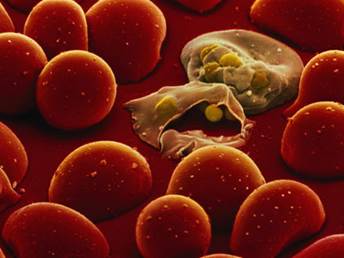疟疾抗青蒿素药性背后的因素
来源:《Science》
作者:Judith Straimer
时间:2014-12-24

在本期杂志中,有两个研究小组报告了新出现的疟疾药物青蒿素抗药性背后的分子机制。
由Judith Straimer领导的一个小组证实,疟原虫K13基因中的“推进器突变”造成了该抗药性。由Sachel Mok和同事所撰写的第二份报告对抗药疟疾中的基因表达进行了检查并得出结论:这些突变可帮助疟原虫修复蛋白并延缓其发育。以青蒿素为基础的治疗在过去的10年中促使疟疾死亡率下降了30%。然而,在东南亚不断增加的对该药的抵抗是该地区根除疟疾的一个重大挫败,且它不久可能也会威胁该药在全球的应用。
为了更多地了解该抗药性及如何克服它,Mok和同事对从罹患急性疟疾的亚洲和非洲患者体内所采集的恶性疟原虫的1043个样本中的基因表达进行了检查。他们确定,K13突变与蛋白修复通路及可改变疟原虫发育早期阶段时间的因子的表达增加有关。
这两类变化似乎可帮助削弱抗药恶性疟中青蒿素的作用。Straimer和同事检查了该药对K13基因的影响,他们设计的K13基因或失去了推进器突变或获得了推进器突变。在来自柬埔寨(那里是首次出现该抗药性的地方)的疟疾样本中,当K13突变被消除时,疟原虫的存活率从13-49%下降至0.3-2.4%。相反,当加入这些与抗药性有关的突变时,研究人员能够将疟原虫的存活率从0.6%推升至2-29%。(来源:生物360)
K13-propeller mutations confer artemisinin resistance in Plasmodium falciparum clinical isolates
Abstract The emergence of artemisinin resistance in Southeast Asia imperils efforts to reduce the global malaria burden. We genetically modified the Plasmodium falciparum K13 locus using zinc-finger nucleases, and measured ring-stage survival rates following drug exposure in vitro; these rates correlate with parasite clearance half-lives in artemisinin-treated patients. With isolates from Cambodia, where resistance first emerged, survival rates decreased from 13–49% to 0.3–2.4% following the removal of K13 mutations. Conversely, survival rates in wild-type parasites increased from ≤0.6% to 2–29% following the insertion of K13 mutations. These mutations conferred elevated resistance to recent Cambodian isolates compared to reference lines, suggesting a contemporary contribution of additional genetic factors. Our data provide a conclusive rationale for worldwide K13-propeller sequencing to identify and eliminate artemisinin-resistant parasites.
原文链接:http://www.sciencemag.org/content/early/2014/12/10/science.1260867.full.pdf




